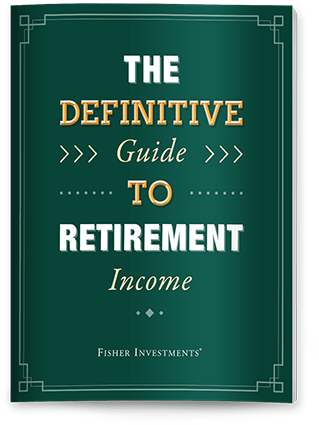Retirement Income Ideas for Your Financial and Lifestyle Choices
Finding retirement income sources that align with your goals might be harder than you anticipate. And once you’ve identified potential retirement income sources, combining them into a well-planned portfolio can be more challenging still. But, with a solid understanding of your options, you should be able to find what works best for you.
You can choose from numerous potential retirement income strategies: Social Security, investment income, rental income or even a part-time job. However, these ideas may not all be right for you. Income-generating investments such as high-yield bonds, dividend-paying stocks and real estate investment trusts (REITs) get a lot of investor attention. While these assets may have a place in a well-constructed portfolio, relying solely on income-producing investments in retirement may leave you underdiversified and unable to generate the growth your financial goals require.
The following are some popular retirement income ideas, their potential benefits and their limitations.
Using Dividend-Paying Stocks for Income
Most companies pay dividends quarterly (four times a year), providing regular income without generating transaction fees. That’s enticing, but, like all investments, dividend-paying stocks come with trade-offs:
- Dividend-paying stocks tend to be overrepresented in certain market sectors such as Consumer Staples, Utilities and Telecommunications. If you rely solely on dividend-paying stocks, your portfolio may be dangerously overconcentrated in a handful of sectors and underexposed to those sectors that lack many dividend-paying companies.
- Regular income is attractive, but dividend payments are discretionary. That means a company can cut or cancel them at any time, potentially putting this income source in danger.

See Our Investment Guides
The world of investing can seem like a giant maze. Fisher Investments has developed several informational and educational guides tackling a variety of investing topics.
Investing in Bonds and Fixed Income
Most bonds offer a steady, repeatable income stream via regular interest payments. This arrangement might give the impression that bonds are among the safest investments available; however, bonds still carry several types of risk:
- Interest rate risk. Interest rates and bond prices move in opposite directions. That means rising interest rates may cause your fixed income holdings to lose value. If you sell before these bonds mature, you may end up losing money on the investment.
- Liquidity risk. It can be difficult to find potential buyers or sellers for some bonds, meaning these investments lack liquidity. In thinly traded, less-liquid markets like this, prices can be more volatile than in deeper, more liquid markets. In a worst-case scenario, a lack of liquidity means you may not be able to find a buyer for your bonds when you’re looking to generate some emergency cash.
- Reinvestment risk. At a bond’s maturity date, the company repays the bond’s principal to the investor, who can then reinvest that money into new bonds. If interest rates have dropped, investors may have to settle for a lower interest rate or purchase a more expensive bond to retain the same level of investment income.
- Default risk. Default risk is the chance that the bond issuer fails to make an interest or principal payment on time. If a company defaults, there’s a chance you may receive back only a small portion of your investment. Therefore, default risk is one determinant of a bond’s yield and a measure of the issuer’s creditworthiness. Just as banks charge higher loan rates to riskier borrowers, higher bond yields can also reflect a bond issuer’s higher credit risk.
In addition to these risks, bonds generally underperform stocks over the long term, which means that with bonds alone, you may not reach your retirement goals as soon as you’d like. However, bonds can still play a role in your retirement income plan, but we generally recommend using them as a buffer against stock market volatility instead of as your primary income source.
Incorporating Annuities
Investors who prefer less-risky investments may be drawn to annuities, which can promise “guaranteed lifetime income.” Annuities can be especially appealing after retirement when investors’ income streams generally shrink. But, annuities come with their share of trade-offs:
- Surrender charges. If you have a significant unexpected expense in retirement and need to pull money out of an annuity earlier than specified in your annuity contract, you may be subject to incredibly high surrender charges depending on the contract.
- Diminished purchasing power. Many annuities lack the ability to adjust for inflation and may impair your future purchasing power. Some annuities do offer inflation-protection features, but for an additional fee.
Using Certificates of Deposit (CDs)
A CD is a promissory note issued by a bank. It entitles the CD owner to predictable interest for anywhere from one month to five years.
Generally, the higher the interest rate on a CD, the longer you’ll be required to lock up your money. This loss of liquidity is the downside to a CD’s predictable returns. In addition, if you need money for an unforeseen circumstance, you may have to pay a significant penalty if you make a withdrawal before your CD matures.
While CDs may give you slightly better returns than the average savings account, they may not be a reliable longer-term growth strategy. Inflation could significantly impact the CD’s purchasing power. For example, a $100,000 CD paying 3% annual interest will generate $3,000 in income. However, the long-term annual average inflation rate is near 3%1. So while the CD paid $3,000, the purchasing power of the $100,000 invested in the CD decreased by $3,000, thereby generating no net real (inflation-adjusted) return.
Incorporating Social Security Benefits
Most retirees should consider Social Security retirement benefits as a supplement to other retirement income, rather than a primary income source. For many, Social Security won’t cover all expenses in retirement. If you plan to rely on Social Security benefits to meet your expenses, you may want to continue working until maximum benefits are available, which is generally at age 70.
Careful Planning and Healthy Diversification
Many of the investments mentioned in this article can be good choices when part of a well-diversified portfolio. Selecting the right investments to generate income in retirement takes skill. To find out more about Fisher Investments’ unique portfolio-construction strategy, familiarize yourself with our top-down investing approach.
1Source: FactSet, as of 3/14/2024; from 12/31/1925 to 12/29/2023, average annualized inflation was 2.96% based on the US BLS Consumer Price Index.





